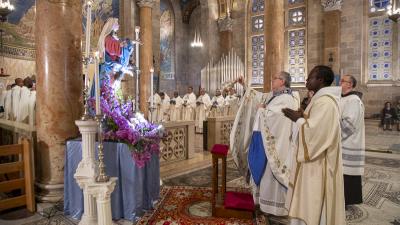
The celebration silently ended on Holy Thursday and Friday’s celebration began quietly. At dawn on April 14, the Holy Sepulcher was once again filled with faithful full of anticipation. The Apostolic Administrator of the Latin Patriarchate, Mons. Pierbattista Pizzaballa, reached Calvary, carrying the wooden relic of Jesus’ Cross, in the very place where it was placed two thousand years ago. The story of Christ’s passion is loudly read by three readers and with the Custody’s choir taking turns. Jesus seemed to be there re-experiencing his suffering, not responding to insults, bearing the Cross again, like every day, out of love. Small details pointed to the fact that this was a moment of deep spirituality: the priests’ red robes, the pilgrims’ watchful eyes, the emotion of feeling the truthfulness of those words inside. As expected on this particular day, the universal prayers were then proclaimed.
“Right in the Place of the Skull, a witness of the Passion and death of our Redeemer and the center of the Earth where mankind received the regeneration of his blood, we accompany Christ in his Passion, venerate the wood of the sacred Cross," said Mons. Pizzaballa. With some difficulty in the cramped space, the faithful and the priests managed to go up to Calvary; they kissed the cross, as a sign of honor and as a symbolic gesture.
On Good Friday, by ancient tradition, the Church does not celebrate the Eucharist, but it was still distributed, after being taken from the Lord’s tomb. At the Basilica of the Resurrection, in the meantime, one could hear the prayer songs of the other Christian denominations. “This place is maybe confusing for people who are there and there are some noises you can hear, but being here, especially on Good Friday, is extraordinary,” said a pilgrim from Poland who did not manage to follow the celebration all the way up Calvary. Her husband Halbert concurred, “I feel confused and impressed at the same time. Listening to the different manners of praying of the various churches is beautiful and it is important for the unity of the church.”
After a few hours, the crowd started to gather in front of the Flagellation, where the first station is. Pilgrims, local parishioners, nuns, seminarians and friars started on the Via Crucis from there. The faithful are of many different ages, origins and they speak different languages. There would have been even more pilgrims if many had not been blocked by the Israeli police trying to maintain order in vain. People waved behind the balustrades: “Let me through! I want to participate, too!” fearlessly yelled a woman who was angry at the soldiers. The luckiest ones managed to reach the first station and the the Via Crucis began. “How exciting!” said Sister Angela several times. She, who is quite agile, would see things before the photographers did. While remaining in front of the crowd, “It is not the first time I that participate. And now I've learned that I need to move!” she confided with a wink.
The alleys of the Old City were full. The faithful followed the voice of Fr. Clovis, who led the prayer with his microphone. Following the Franciscans, the parish procession was guided by Scouts from the Old Town. Youngsters Mark and Samir were among them, dressed in green, with the classic cub scout scarves around their necks. They commented: “For many, it is their first time, but we are here every year! It is always good. We feel part of all of this: it happened right here, in what is now our city.” Both processions, one after another, prayed retracing Christ’s painful journey. For a moment, before the eighth station, the crowd was silent. Hundreds of people were in silence. The atmosphere was very different from the joyous Palm Sunday celebration. Station after station, the group reached the Holy Sepulcher. They got up to Calvary, limping. They solemnly stopped in front of recently restored Edicule. The Fourteenth Station: Jesus is laid in the Tomb after being taken down from the cross. The procession ended there. Fr. Oscar, after shaking hands with some pilgrims, explained: “There is an interesting phenomenon here. In the rest of the world, we celebrate the time: Good Friday, Holy Saturday... are celebrated every day. Instead, here we celebrate the time but also the space; we are in the places of the life, death and resurrection of Jesus.” This is precisely the singularity of this Via Crucis, and this is the very uniqueness of Holy Week in Jerusalem.
BG - AP




